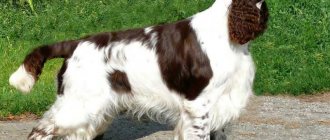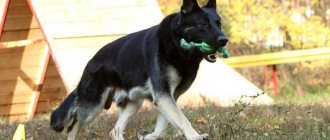This breed was bred in Germany at the end of the 19th century and bears the name of the first breeder - Karl Friedrich Louis Dobermann. However, there is no specific information regarding the origin of the Doberman, since the breeder did not keep records.
In appearance, this is a strong and well-built dog, which skillfully combines strength and grace.
The Dobermann is famous for its intelligence and predisposition to training, thanks to which it has proven itself well in its professional activities.
Moreover, dogs have an excellent sense of smell, which contributes to career advancement in the field of bloodhounds.
So how to properly train and raise a Doberman? Our article will answer this question.
Is the breed easy to train?
To answer this question, it is enough to study the statistics on registered dog breeds. For example, out of 400 breeds, only 9 have received the official designation “service dog”. And the Doberman is among them.
Stanley Conor also mentioned the breed in his book “Dog Intelligence,” where he recognized the Doberman’s abilities and included it in the list of breeds with excellent trainability.
NOTE!
Since ancient times, the Doberman has been a human guard, whose task was to protect and attack, so training is a fundamental factor in pacifying the militant nature of this animal.
However, Dobermans are not as scary as they seem, and with the right approach they can easily be trained.
At what age should you start?
As a rule, from 3-16 weeks the puppy begins to actively explore the world around him, and from this moment his socialization and training begin, since this is an excellent time to come to an understanding of the person and an awareness of the situation in the house.
The pet learns gestures, begins to distinguish praise from blame, and learns to arrange logical chains in order to know in the future what reaction this or that action may cause.
At the age of 4 months, the puppy remembers everything perfectly. In addition, there is a distinction between dangerous and safe, so violence against an animal is unacceptable - the effectiveness of training has nothing to do with physical punishment.
Expert opinion
Kozhevin Semyon Kirillovich
Expert dog handler.
The Doberman was bred as a bodyguard dog, so it follows commands very well, but not if the owner is in real danger. Here the dog will make the decision itself. The Doberman is easy to train, but is also not averse to messing around if the lesson seems uninteresting. The main thing is to properly motivate the animal, influence it and encourage it to action, but this is a matter of individual preference. The Doberman easily makes contact using both the “stick” and the “carrot”.
Training and education of the Doberman
Training a Doberman requires patience. These dogs are extremely intelligent and can sometimes pretend that they do not understand the actions shown to them. The owner requires endurance. Each new trick must be honed for 15 minutes, and the beginning of the next training session should be devoted to repeating the learned commands. Young animals often use tricks in training, and Doberman puppies are no exception to the rule.
A video showing how you can hone simple and complex commands can be viewed online.
The consciousness of the domestic Doberman is entirely aimed at protecting its owner and his family members. Even when resting, the dog is alert and listens to what is happening on the street and in the house. Such a pet will never allow “their own” to be offended and will not miss the opportunity to punish the offender. This dog is always ready to fight. Since this is a large breed, it makes sense to pay as much attention as possible to obedience training. A dog that cannot be controlled, especially in emergency situations, can cause not only inconvenience, but also harm.
The Doberman must unquestioningly follow the following commands: “Fu,” “Sit,” “Stand.” They need to be honed constantly.
If you bought a Doberman puppy and are unsure of your abilities regarding training, it is better to leave this mission to professionals and contact a kennel club. Lack of experience in raising such a breed can not only produce an ill-mannered animal, but also harm the dog’s psyche.
What can be taught?
The breed has successfully proven itself in many types of service and sports, so the last thing the owner should worry about is the range of activities of the dog.
Doberman Pinschers are predisposed to:
- search and rescue service;
- protective guard service;
- search (search for things, people, animals, prohibited means, etc.);
- protection of territories or property;
- “bodyguard dog” positions.
Dogs have a number of useful characteristics. Thanks to their sense of smell and intelligence, they are in demand at customs, serve in the police and at the border.
These animals are easily given OCD, so if the owner does not intend to build a career for the pet in official activities, then you can always give in to sports.
Animals demonstrate good learning ability in competitions in:
- canicross (musher dog);
- dog-pulling (tug-of-war);
- agility (speed overcoming barriers);
- frisbee dog (catching a flying disc);
- waitpulling (dragging a load over a certain distance);
- pitch-and-go (quick fetch offering);
- freestyle (a combination of obedience exercises and tricks to music);
- bike joring (a sledding sport where instead of a dog sled, dogs pull a bicycle);
- scooter (a type of snowless sport where the dog pulls the owner behind him on a scooter);
Doberman is without a doubt a worthy competitor in the fight for the main prize.
From the history of the breed
The Doberman is a noble German breed of working dog that, according to its creator, combines elegance and power. It is curious that they are the only ones named after their breeder - Friedrich Lewis Dobermann. He was a tax collector by profession, and imagined the ideal dog as a formidable guard.
Unpretentiousness, courage and vigilance are the main features of the Doberman. To achieve them, they combined in the animal:
- shepherd;
- Rottweiler;
- pinscher;
- mastiff;
- Greyhound.
Due to its characteristics, the Doberman is perfect for protective guard service, protection of owners, their area and property. This is a serious dog that not everyone can train. It is worth considering that the Doberman will never be a servant or a thoughtless performer - the breed interacts with humans almost on equal terms. He will not carry out useless commands like “bring the slippers.” But he will quickly learn “Fas”, “Aport”, and will risk his life to protect his master and family members. Even a small child can be trusted with a properly trained Doberman.
Basic rules of training
Training rules:
- In the first stages of training, the relationship between the owner and the animal is established;
- Training in techniques progresses as the puppy grows and from simple to complex;
- Correct execution of a command is worthy of praise and treats, which reinforces the acquisition of the skill;
- Consistency is important when training, otherwise it will be difficult for the dog to understand what is possible and what is not. The Doberman does not like ambiguity. This will encourage an attempt to take over leadership in the house;
- It is recommended to study a new technique at first. The recommended time for training is 2-3 hours before and after feeding, in the morning and in the evening.
IMPORTANT!
Food aggression is common among Dobermans, so be careful not to overuse treats when rewarding them. Use toys instead of food.
When to start training?
Raising and training a Doberman begins as soon as the puppy appears in the house. Kids of this breed are very cute and funny, but it is wrong to postpone the start of classes until later. The seemingly defenseless and unintelligent puppy is actually looking for a leader from the very first days. If he realizes that you are showing weakness, he will quickly take control into his paws. It will not be easy to correct training mistakes in an adult dog later, even with an experienced instructor.
Before purchasing a Doberman puppy, you need to prepare a bed for him, a place where he will eat and toys. A healthy baby is very playful and cheerful, he will like all the objects with which he can play. In addition, they will be useful in education.
Dobermans work great for food. But in order not to feed them and provoke food aggression, it is worth switching over time to rewarding them with toys. It is better to give preference to playing with objects that end up with the owner: a ball, a stick. But games with tugging things are prohibited: this can undermine your position as a leader. Also prepare objects that you can chew with impunity - the puppy’s teeth will cut and itch.
How to become an authority for a dog?
Hierarchy is a matter of time. If the owner is not interested in the position of leader, then the dog will take it. This is explained by the animal’s desire to live in a pack, where one of the individuals performs the duties of a leader and serves as a symbol of security.
A guide for beginner “two-legged leaders”:
- Set certain boundaries about what is allowed, whether it is regarding food or where to sleep. Do not follow the pet’s lead in his attempt to beg something from the master’s table;
- Do not allow your dog to enter your area (bedroom) without permission. And in relation to a neutral area (such as a living room), climb onto the niche first (sofa, armchair);
- Approval and censure follow the action. Don't punish an animal without reason;
- Stop aggression;
- Don't poison your dog on others for fun. The leader reacts only to a real threat;
- The right to decide when it is time to play rests with the owner;
- When you return home, do not let your dog get ahead of itself. The owner is the first to enter the house, and only after that the four-legged friend;
- Do not panic in the company of a pet (squealing, fussing). Dogs are sensitive to behavior changes.
Training by month
The table provides information on how to distribute the training and education of a Doberman puppy by month:
| Age | Education and training |
| 1-2 months | The puppy gets used to its name and explores the new area. During this time, the owner teaches the pet to go to the toilet using a film and makes attempts to accustom the puppy to a collar and leash. The next point is to define the boundaries of what is permitted:
|
| 3 months | At this time, the puppy’s nervous system is being formed, so the pet needs to expand the boundaries of the outside world. At the same time, the list of rules is updated:
|
| 4-5 months | By this point, the puppy has already gotten used to it and has learned a couple of interesting tricks, for example, pretending that he doesn’t hear you when you call him. In order to stop the first signs of disobedience, it is time to move on to the next stage - training. The puppy is taught:
|
| 6 months | If months earlier the first signs of disobedience appeared, now we have before us a real rebel. This is the time when the puppy begins to re-explore the boundaries of what is permitted and test the strength of the owner’s patience. The pet stops responding to the owner’s orders, shows exceptional indifference to what is happening, and only in order to study the reaction. |
Raising a puppy
You need to start training a Doberman from the first days of his stay in the house. Training should be carried out based on the age characteristics of the animal.
1-2 month
During the first two weeks, the puppy gets used to its name and new place, explores the environment, determines its status and that of its owner. During this period, it is necessary to pay as much attention as possible to the new family member and create an atmosphere of trust.
Gradually, the little Doberman begins to be accustomed to a daily routine, walks, and is introduced to the external environment. When walking, do not avoid crowded or noisy places. There is no need to overload your pet with long sessions or try to teach complex commands. Training should be carried out in the form of a game.
3-4 month
At this age, Dobermans become active and curious, often creating difficult situations. During this period, you can begin to train the puppy.
It is better to carry out training in the form of a game, which will contribute to the growth of the baby’s skills: the ability to hide, catch up, jump, and overcome barriers, defend, and perform a simple search for objects. Class time is no more than 15 minutes.
4-6 month
The Doberman continues to learn how to communicate with others. By this time, his basic skills and abilities should be consolidated. The dog must clearly define its status and status as its owner. New, more complex tasks are added to the initial elements of training and practiced (author of the BestDog video E. Maksimova).
6-9 months
One of the most difficult periods of parenting occurs between 6-9 months. Due to the onset of puberty, the puppy's performance and attention decrease. Young males become interested in sexual games and learn how to behave in a pack. At this stage, all commands and skills must be consolidated and brought to perfection.
How to teach behavior on the street?
Often, owners witness when a dog flatly refuses to obey - tries to pull out the leash, shows aggression towards passers-by, or collects small change from the ground with interest.
Firstly, you are taught not to pick up dogs from the ground in early childhood. The signal is the command “Fu” and its emotional connotation. A muzzle also copes with this task.
Secondly, aggression is a defensive reaction, which can also be a consequence of an incorrect relationship between a person and a dog.
Thirdly, walking is another way to learn something new rather than deviate from the old. A pet’s disobedience is a reason not only to think about the method of education, but also to bring it to automaticity.
NOTE!
The Doberman must learn that “who leads whom, leads,” and not vice versa. As a rule, a tight leash brings discomfort to the dog, and this is a reason to wonder what’s wrong? Therefore, the Doberman must at least stop.
First teams
In the period from 4 to 6 months, the first commands are practiced with the puppy: “Come”, “Place”, “Ugh”. The baby will remember the nickname a few days after appearing in the house. It is important to make sure that all family members call him the same, and do not change the name yourself to, for example, an affectionate diminutive. Encouragement is expressed in a gentle tone, and not with different nicknames, otherwise the puppy will get confused.
There will be no problems with the "Place" command. But “Come to me” and “Fu” will require persistence. You need to force the Doberman to follow commands, even harshly. For example, you can do this: agree with a friend to stock up on small pebbles or peas. When the puppy shows disobedience after the command “Come!”, you should start throwing these objects at him. The owner, when the dog finally runs up to him, calms it down in every possible way. Then the Doberman gets the idea in his head: “The owner is good, he takes care of me. He didn’t want rocks to start falling on me, that’s why he called me.” Next time you can count on unquestioning obedience.
The “Fu” command is learned using a rustling newspaper. There is no need to try to cause pain - a light tap on the nose is enough.
Basic command training
The “Sit” command is taught both at home and outdoors. After voicing the decree, sit the animal down. Press down on the sacrum with one hand and hold the dog over the head with the other, grabbing the treat. The exercise is repeated at intervals of 3-5 minutes.
The command “Sit” is given by the gesture of raising the right hand at ear level. Therefore, subsequent consolidation of the skill eliminates physical coercion on the part of the owner. On the contrary, the distance between man and dog increases, as does the waiting time.
Remember that the owner must release the puppy and only by decree. The signal is the command “Walk”.
The “Lie down” command is carried out similarly to the “Sit” command, namely, with alternating coercion and encouragement. The owner presses on the withers and at the same time stretches the dog's front legs, forcing the dog to lie down. The position is held for 10-20 seconds, after which it is encouraged. Unlike the previous command, here the gesture involves a horizontally raised hand, which is then lowered to the thigh.
It is recommended to train the “Fu” command on a leash and exclusively near the object of irritation. As soon as the dog makes an attempt to attack the object, the owner gives an order and pulls the leash towards himself. Correct execution of an order is stimulated by a reward.
The “Come to me” command is carried out with the participation of a third person. The helper takes the puppy in his arms, after which the owner comes up and gives the pet a treat from his hands. Next, the assistant moves back up to 2 meters and places the puppy on the ground. The main thing is not to forget to hold the pet so that it does not rush after the owner ahead of time. When the owner commands “Come to me,” the assistant releases the pet. If the puppy does not react, then the owner shows the treat after squatting down.
Teaching Doberman basic commands
Doberman training at home should be approached very responsibly. Young dogs learn quickly, but with insufficient physical and mental stress, errors in upbringing and training, they can become uncontrollable, show aggression, and sometimes even bitterness.
The optimal time to start training is considered to be 8-12 weeks. The first training lessons should last no more than 10 minutes, regularly.
Basic commands that a Doberman must be taught in the first year of life:
- "Place!". One of the very first commands that a puppy learns. Disciplines the pet and helps control its movements.
- "To me!". It induces in the dog the skill of reliably approaching the owner upon command or gesture.
- "Ugh!". A prohibiting command prevents attempts to show interest in unwanted objects.
- "Near!".
- “Sit!”, “Stand!”, “Lie down!” A set of commands that keep the dog in a certain position.
- “Aport!” The skill of lifting and carrying an object.
Useful skills that will simplify the training process:
- calm attitude towards the muzzle;
- neutral attitude towards spilled food or treats offered from a stranger;
- calm reaction to loud sound;
- ability to overcome mechanical obstacles: stairs, barriers, boom.
Before starting the training course, the owner must ensure that the following auxiliary details are available:
- leash 5-8 meters long;
- short leash, 1-2 meters;
- mat (practice “Place!”);
- the object being imported (for example, a toy);
- reward item (treat, toy).
Most common mistakes
Mistakes that Doberman owners most often make when training their pets:
- lack of an individual approach;
- there is no specific sequence in developing techniques and organizing training sessions;
- overtraining (overtiring the dog);
- using the wrong stimuli;
- underestimation of the impact of other irritants on the dog;
- abuse of a strict collar (parfors);
- erroneous intonation in the voice when issuing commands;
- repeated repetition of the command “Fu”;
- incorrect delivery of instructions;
- inappropriate encouragement.
How much do dog handler services cost?
Let's consider the average cost of providing services with a dog handler visiting your home:
| Service | Price, rub |
| General training course (GTC) | 1700 |
| General obedience course (puppies) | 1700 |
| Behavior correction (aggression) | 200 |
| Managed City Dog (UGS) | 1700 |
| Training a dog for protection (ZKS) | 2000 |
| Group lessons (from 3 dogs) | 800 |
| Group classes on site (Course 10 lessons) | 8500 |
Further training
If the owner's obedience course and the initial commands were successful, you can begin training new commands. “Nearby”, “Fetch” - these are the commands that the puppy is able to carry out. He must also learn to walk on a leash, calmly endure examination by a veterinarian, and socialize. For the latter, it is important to take him for walks more often in crowded places, introduce him to other dogs, while stopping aggression.
In any case, it is important to decide before six months of age whether you can train the dog yourself or whether you need help. Training a Doberman according to the ZKS course - protective guard service - is not an easy task. By entrusting her to the professionals from our club, you will be able to enjoy a balanced and loyal pet. You can also complete the general course program, come to group classes and special preparation for exhibitions.
The Doberman is an excellent watchdog and friend, but only if he is obedient. In order not to get into trouble, the owner should not waste time and money on training.











